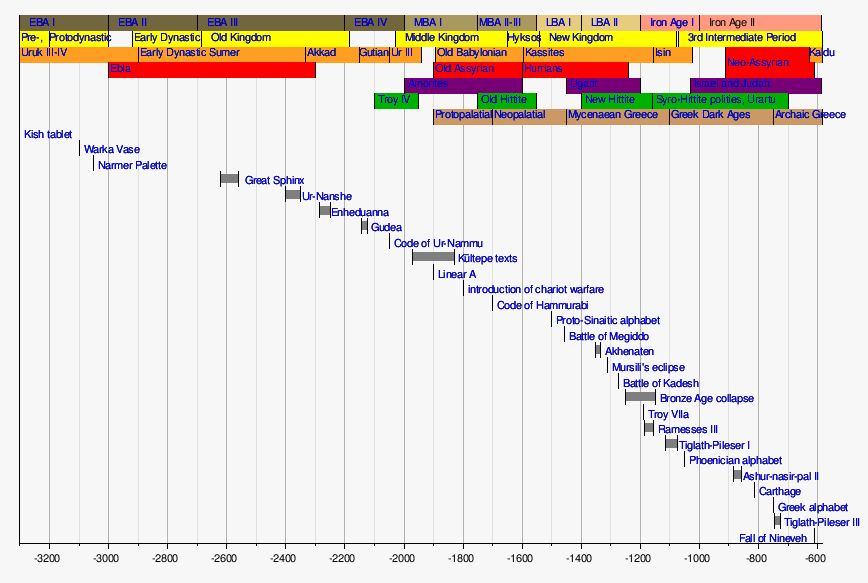This is an old revision of this page, as edited by Sumerophile (talk | contribs) at 17:46, 3 February 2008 (moving the flood stuff to Sumerian origin legend). The present address (URL) is a permanent link to this revision, which may differ significantly from the current revision.
Revision as of 17:46, 3 February 2008 by Sumerophile (talk | contribs) (moving the flood stuff to Sumerian origin legend)(diff) ← Previous revision | Latest revision (diff) | Newer revision → (diff)Template:FixBunching Template:Mesopotamian myth (heroes) Template:FixBunching
| Ancient Mesopotamia | ||||||
|---|---|---|---|---|---|---|
| Geography |
|  | ||||
| (Pre)history |
| |||||
| Languages | ||||||
| Culture/society |
| |||||
| Archaeology | ||||||
| Religion | ||||||
| Academia | ||||||
Ziusudra (also Zi-ud-sura, Zin-Suddu, Hellenized Xisuthros: "found long life" or "life of long days") of Shuruppak is listed on some versions of the Sumerian king list as the last king of Sumer before the Flood. He then becomes the hero of the Sumerian flood myth.
Ziusudra
Sumerian king list
Ziusudra, or Zin-Suddu, appears in the WB-62 version of the Sumerian king list as a king/chief of Shuruppak who reigned for 10 (shar) years. Ziusudra was preceded in this king list by his father Su-Kur-Lam who was also king of Shuruppak and ruled 8 (shar) years. On the next line after Ziusudra in the King List are the sentences "The flood swept thereover. After the flood swept thereover, ... the kingship was in Kish." The city of Kish flourished in the Early Dynastic period soon after an archaeologically attested river flood in Shuruppak that has been radio-carbon dated about 2900 BC. Polychrome pottery from below the flood deposit have be dated to the Jemdet Nasr period that immediately preceded the Early Dynastic I period.
The importance of Ziusudra's name on the king list is that it links the flood mentioned in the Epics of Ziusudra, Atrahasis, Utnapishtim, etc. to river flood sediments in Shuruppak, Uruk, and Kish that have been radio carbon dated as 2900 BC. So scholars conclude that the flood hero was king of Shuruppak at the end of the Jemdet Nasr period (3000-2900) which ended with the river flood of 2900 BC.
Ziusudra being king of Shuruppak is supported in the Gilgamesh XI tablet (see below) by the reference to Utnapishtim (Akkadian translation of Ziusudra) as "man of Shuruppak" at line 23.
Sumerian flood myth
The tale of Ziusudra is known from a single fragmentary tablet of the Eridu Genesis, written in Sumerian, datable by its script to the 17th century BC (Old Babylonian Empire), and published in 1914 by Arno Poebel. The first part deals with the creation of man and the animals and the founding of the first cities - Eridu, Bad-tibira, Larsa, Sippar, and Shuruppak. After a missing section in the tablet, we learn that the gods have decided to send a flood to destroy mankind. The god Enki (lord of the underworld ocean of fresh water and Sumerian equivalent of the Babylonian god Ea) warns Ziusudra, the ruler of Shuruppak, to build a large boat - the passage describing the directions for the boat is also lost. When the tablet resumes, it is describing the flood. A terrible storm raged for seven days, "the huge boat had been tossed about on the great waters," then Utu (the Sun) appears and Ziusudra opens a window, prostrates himself, and sacrifices an ox and a sheep. After another break, the text resumes, the flood is apparently over, and Ziusudra is prostrating himself before An (sky-god) and Enlil (chief of the gods), who give him "breath eternal" and take him to dwell in Dilmun. The remainder of the poem is lost. (text of Ziusudra epic)
A Sumerian document known as The Instructions of Shuruppak dated by Kramer to about 2500 BC, refers in a later version to Ziusudra. Kramer concluded that "Ziusudra had become a venerable figure in literary tradition by the middle of the third millennium B.C."
See also
Notes
- S. Langdon, "The Chaldean Kings Before the Flood," Journal of the Royal Asiatic Society (1923), pp 251-259.
- Langdon, p. 258, note 5.
- Harriet Crawford, Sumer and the Sumerians, Cambridge Univ. Press, 1991), p. 19.
- Erik Schmidt, Excavations at Fara, 1931, University of Pennsylvania's Museum Journal, 2 (1931), pp 193-217.
- M.E.L. Mallowan, "Noah's Flood Reconsidered", Iraq, vol 26 (1964), pages 62-82.
- "The Sumerian Flood Story" in Atrahasis, by Lambert and Millard, page 138
- Samuel Noah Kramer, "Reflections on the Mesopotamian Flood," Expedition, 9, 4, (summer 1967), pp 12-18.
References
- W. G. Lambert and A. R. Millard, Atrahasis: The Babylonian Story of the Flood, Eisenbrauns, 1999, ISBN 1-57506-039-6.
- R. M. Best, Noah's Ark and the Ziusudra Epic, Eisenbrauns, 1999, ISBN 0-9667840-1-4.
External links
- A comparison of equivalent lines in six ancient versions of the flood story
- Ancient Near East flood myths All texts: (Ziusudra, Atrahasis, Gilgamesh, Genesis, Berossus), commentary, and a table with parallels
- ETCSL - Text and translation of the Sumerian flood story (alternate site)
Template:Notable Rulers of Sumer navbox
| Timeline of the ancient Near East | |
|---|---|
 | |